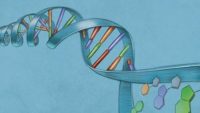A 15-year-long project finally bore fruit after researchers painstakingly identified a specific gene mutation that can lead to sudden heart failure in otherwise healthy-looking young people. These newly published results counter the long-standing view that mutations can somehow drive evolutionary innovation. More… …read more Read more here: icr.org
“More marvels of design that we are supposed to believe were the product of random chance processes … yeah, right.” Admin Scuba divers can explore underwater depths firsthand because of specialized equipment that was developed in just the last century. Likewise, solar-powered airplanes currently in development promise to provide fuel-free flying. These inventions open new realms for human exploration, but the arachnid and insect equivalents of their equipment have been on the planet for ages. Scuba is a stand-alone word today, but it began as the acronym for “self-contained underwater breathing apparatus,” so named because it supplies breathable air underwater. [More]
Scientists are discovering engineering details of the biological structures that enable some animals to jump exceedingly far for their sizes. Froghoppers are insects that can jump 100 times their body length, and it turns out that sheer muscular strength is not nearly sufficient to account for this feat. Read More: Insect Designed with a Spring in Its Step | The Institute for Creation Research
Sea urchins are spiny marine animals. Some of them like to hide in holes that they dig out of limestone in the ocean floor, using teeth that are ground down and yet remain sharp. What makes these teeth so special that they can drill through rock and not go blunt? Israeli scientists found remarkably precise and efficient construction when they took a close look at the sea urchins’ teeth. Using various high resolution imaging techniques, they saw tiny edges of magnesium calcite crystals exposed on the tooth surfaces. The sea urchins manufacture these crystals so that as the tooth wears [More]
When mud that encases the larva of a particular African horsefly dries out and breaks up, it does so in a way that protects the insect. …read more Read more here: creation.com
By Dr. Elizabeth Mitchell Observable science confirms preserved collagen fragments in dinosaur bone are authentic, but does not show protein can be preserved for millions of years. …read more Read more here: AIG Daily
By Dr. Elizabeth Mitchell Saccorhytus is, the authors believe, the oldest and simplest known deuterostome, the evolutionary forebear of all vertebrates and some invertebrates. …read more Read more here: AIG Daily
By Ken Ham We’ve pointed out many times that the topic of creation vs. evolution isn’t science vs. the Bible or science vs. religion. It’s one interpretation of the evidence competing with a different interpretation of the evidence. I thought I would use a new study that came out of my homeland of Australia as an example to show you how this works. Looking Through Secular Lenses Researchers are studying hairs from Australian aborigines to “help reconnect indigenous families with ancestral communities.” Here are their conclusions and interpretations based on the genetic data: “Aboriginal Australians descended from a single population [More]
‘Fossil fuel’ takes a lot less time to form than commonly believed …read more Read more here: creation.com
By Dr. Tommy Mitchell A healthy body requires more than working parts. Somehow they must work together for optimum performance. …read more Read more here: AIG Daily
The household moggy has a much more complicated family tree than previously thought. …read more Read more here: creation.com
Bumblebees and spiders display behaviours beyond what was previously considered possible. …read more Read more here: creation.com
A recent science news article sheds light on the amazing squid, but definitely not on its supposed evolution or origin. Creation scientists maintain squid have always been squid, and science bears this out with a new and highly detailed squid fossil. More… …read more Read more here: icr.org
By Dr. Andrew Fabich While it’s often swept under the rug, we shouldn’t dismiss the amazing design found in soil particulates. …read more Read more here: AIG Daily
By Dr. Don DeYoung Some realities of nature are so common that we don’t even stop to ask why. Like round trees. …read more Read more here: AIG Daily
A Bobbit worm is a predatory sea worm that submerges beneath sandy sea bottoms. Lying still with its fanged jaws ready, it waits, then grabs and drags its prey underground. New evidence supports the idea that special creation, not evolution, explains this unique worm’s body construction. More… …read more Read more here: icr.org
Scientists were surprised to find one instance of lorikeets eating meat. Then the public told them of hundreds. …read more Read more here: creation.com
By Ginger Allen This article addresses these and other questions regarding post-Flood plant survival and dispersal, and consider mechanisms by which this may have occurred. …read more Read more here: AIG Daily
A tiny lizard can perform feats that superheroes can only dream about. …read more Read more here: creation.com
Did you know that the electrostatic properties of spider webs, and a ‘quirk of physics’, causes them to actively spring towards airborne objects? …read more Read more here: creation.com
Many believers in nature’s capacity for evolutionary innovation think the sky’s the limit-yet their allegedly ‘naturalistic science’ writings betray a faith in the abilities of ‘Nature’ that borders on paganism. …read more Read more here: creation.com
By Heather Brinson Bruce Evolution is hard-pressed to explain this prickly little digger. That’s because the Creator made it like no other single animal. …read more Read more here: AIG Daily
Is the Tibetan snow lotus evolving to elude detection? …read more Read more here: creation.com
A functional body plan is the key to life; without it, an embryo will not survive. …read more Read more here: creation.com
Prevailing secular theory considers birds to be living dinosaurs, but new science is hatching to support the stark differences between these creatures. The data demonstrate dinosaurs were more likely cold-blooded like all modern reptiles. More… …read more Read more here: icr.org
By Prof. Stuart Burgess Our ability to communicate and understand, feel emotions, and think rationally shows that we are created for a purpose—to have a relationship with God. …read more Read more here: AIG Daily
The idea that spacecraft can be built that can travel vast distances in a short time fails at a theoretical level, despite what Hollywood and evolution would have us believe. …read more Read more here: creation.com

















![Love Can Turn the World [Live] Love Can Turn the World [Live]](http://img.youtube.com/vi/5pSCJkLyvKQ/0.jpg)























